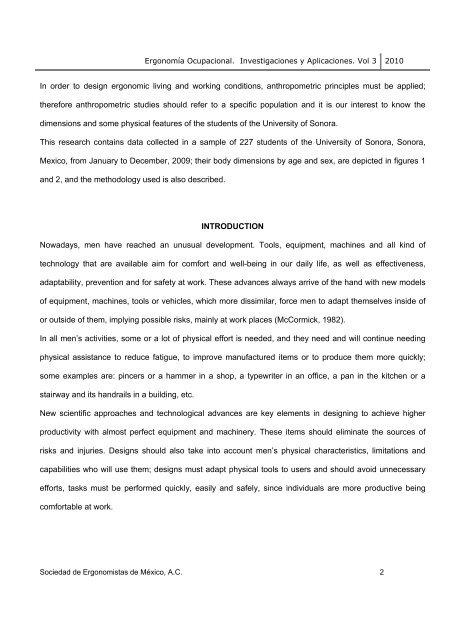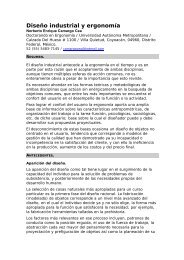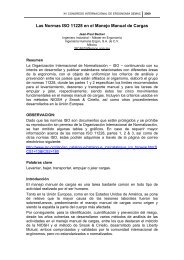ERGONOMÍA OCUPACIONAL - SOCIEDAD DE ERGONOMISTAS ...
ERGONOMÍA OCUPACIONAL - SOCIEDAD DE ERGONOMISTAS ...
ERGONOMÍA OCUPACIONAL - SOCIEDAD DE ERGONOMISTAS ...
You also want an ePaper? Increase the reach of your titles
YUMPU automatically turns print PDFs into web optimized ePapers that Google loves.
Ergonomía Ocupacional. Investigaciones y Aplicaciones. Vol 3 2010<br />
In order to design ergonomic living and working conditions, anthropometric principles must be applied;<br />
therefore anthropometric studies should refer to a specific population and it is our interest to know the<br />
dimensions and some physical features of the students of the University of Sonora.<br />
This research contains data collected in a sample of 227 students of the University of Sonora, Sonora,<br />
Mexico, from January to December, 2009; their body dimensions by age and sex, are depicted in figures 1<br />
and 2, and the methodology used is also described.<br />
INTRODUCTION<br />
Nowadays, men have reached an unusual development. Tools, equipment, machines and all kind of<br />
technology that are available aim for comfort and well-being in our daily life, as well as effectiveness,<br />
adaptability, prevention and for safety at work. These advances always arrive of the hand with new models<br />
of equipment, machines, tools or vehicles, which more dissimilar, force men to adapt themselves inside of<br />
or outside of them, implying possible risks, mainly at work places (McCormick, 1982).<br />
In all men’s activities, some or a lot of physical effort is needed, and they need and will continue needing<br />
physical assistance to reduce fatigue, to improve manufactured items or to produce them more quickly;<br />
some examples are: pincers or a hammer in a shop, a typewriter in an office, a pan in the kitchen or a<br />
stairway and its handrails in a building, etc.<br />
New scientific approaches and technological advances are key elements in designing to achieve higher<br />
productivity with almost perfect equipment and machinery. These items should eliminate the sources of<br />
risks and injuries. Designs should also take into account men’s physical characteristics, limitations and<br />
capabilities who will use them; designs must adapt physical tools to users and should avoid unnecessary<br />
efforts, tasks must be performed quickly, easily and safely, since individuals are more productive being<br />
comfortable at work.<br />
Sociedad de Ergonomistas de México, A.C. 2




